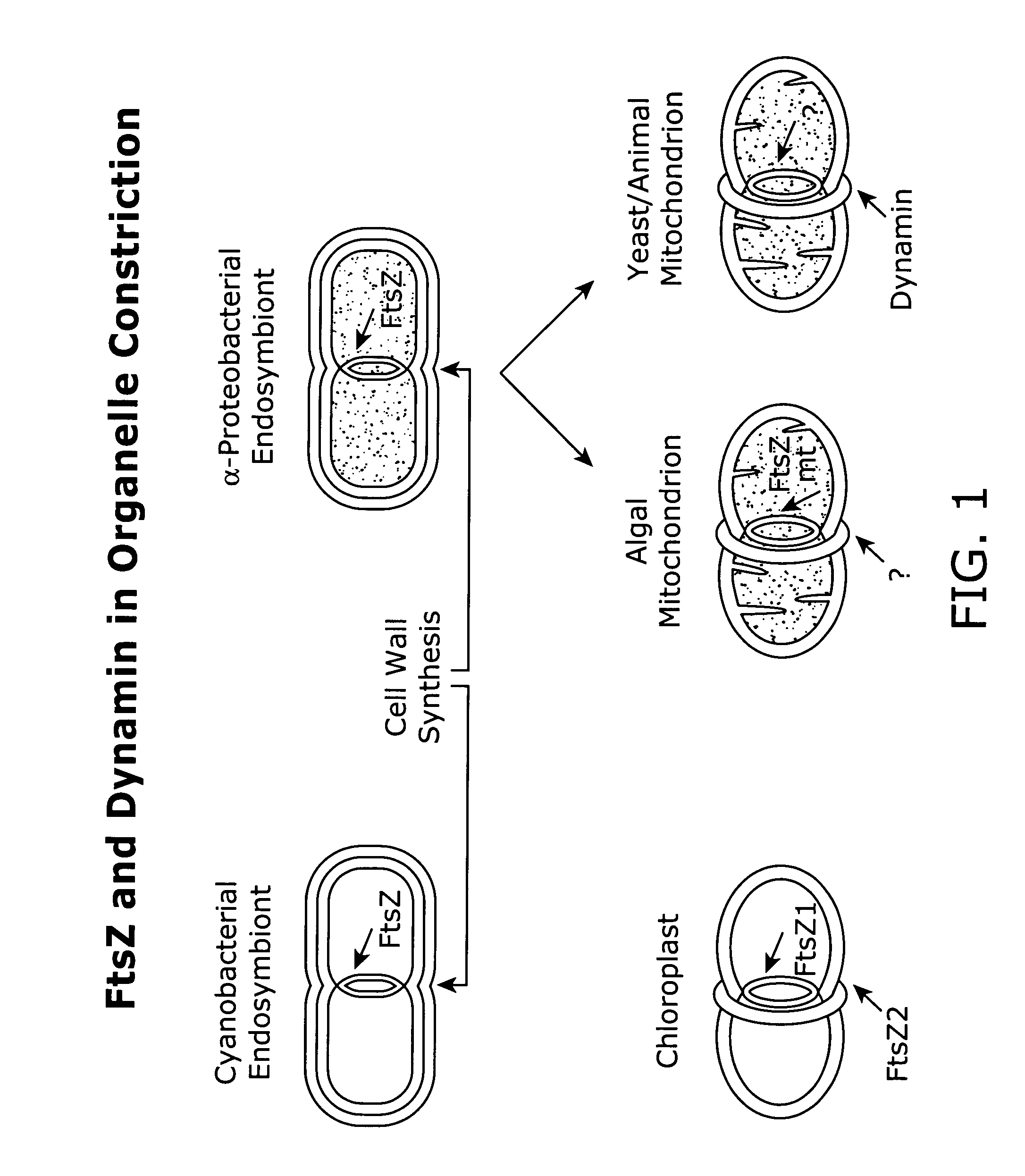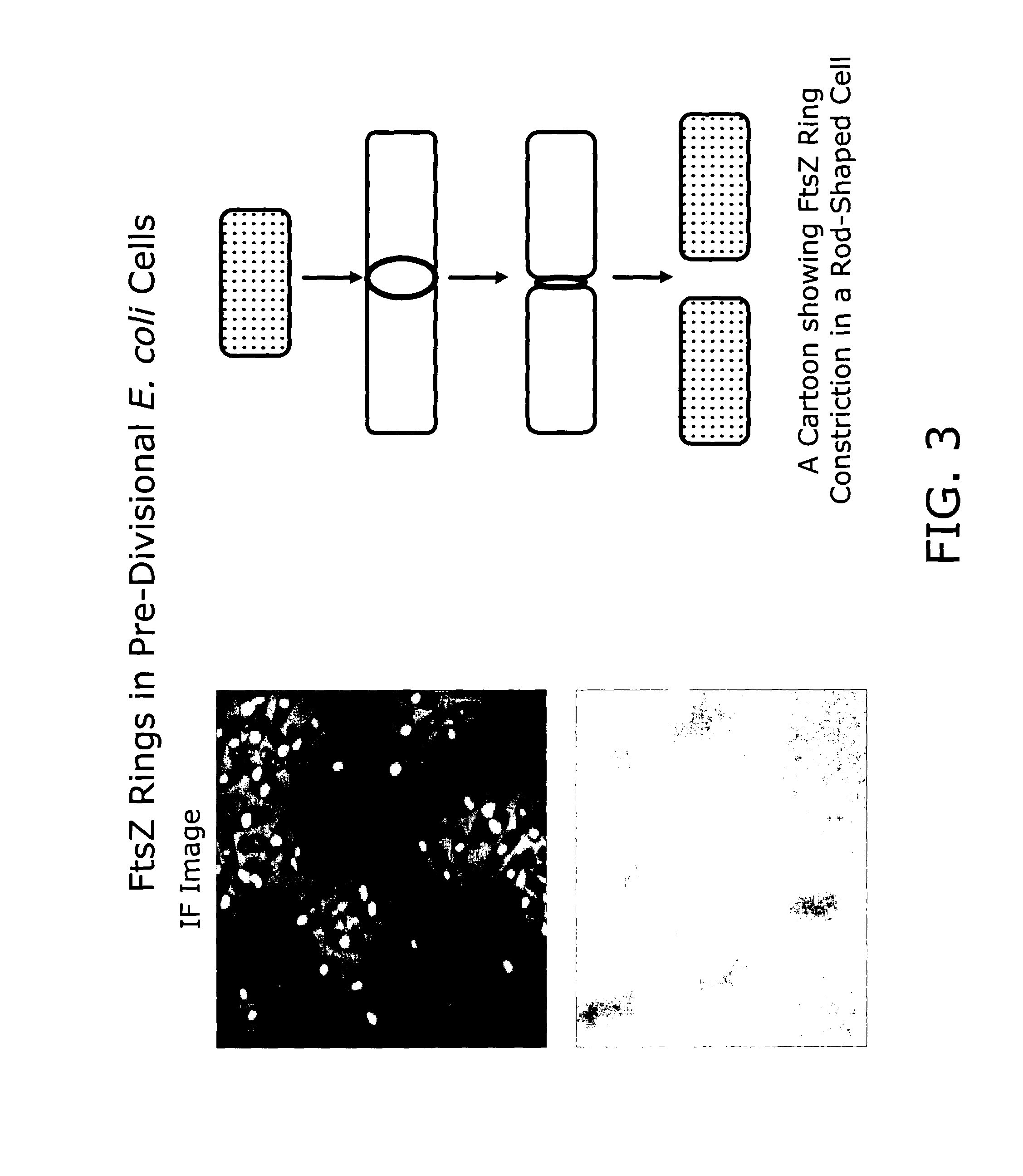In vivo assay for identification of antimicrobial agents
a technology of antimicrobial agents and assays, which is applied in the field of in vivo assays for identification of antimicrobial agents, can solve the problems of increased treatment costs, longer patient hospitalization, and high morbidity and mortality, and achieves minimal side effects and improved bioavailability.
- Summary
- Abstract
- Description
- Claims
- Application Information
AI Technical Summary
Benefits of technology
Problems solved by technology
Method used
Image
Examples
example 1
In Vivo Assay for FtsZ Inhibitors or Activators
Materials and Methods
[0153]First Screen Variation: A differential in vivo screen was carried out at 30° C. by looking for greater than or equal to 45% growth inhibition and phenotypic aberrations (e.g., changes in filamentation or cell shape (e.g., rod to sphere) or minicell formation) of the DRC39 strain, which is deleted for the multidrug efflux pump AcrAB, and its isogenic fts84 variant DRC 40. Libraries were screened with two different concentrations of compound using 5- and 100 nl pin transfer devices.
[0154]Bacterial cultures were grown overnight at 30° C. in 0.5% NaCl Luria Broth (LB) with 20 μg / ml kanamycin and diluted 1:1000 (OD600 of 0.005) in fresh 0.5% NaCl LB. The Labsystems 384-well liquid dispenser was used to dispense 40 μl of the diluted culture to the first 23 columns of a clear NUNC 384-well plate, leaving one column empty for manual addition of the blank samples. 100 nl or 5 nl of compounds were transferred from a 384...
example 2
Verification FtsZ Inhibitor Activity Using Vivo Assays
[0164]This example describes the use of an in vivo assay for the identification of small molecule inhibitors that effect bacterial cell division through the protein FtsZ.
[0165]A small molecule inhibitor of FtsZ activity, 26E-10, 27F02, 58P-18, was identified using the in vitro NADH assay (see U.S. patent application Ser. No. 10 / 153,268. Additional compounds were preliminarily identified from the MDS1 galanthamine library using the NADH assay. For example, FIG. 29 in U.S. patent application Ser. No. 10 / 153,268 depicts the percent inhibition measured by the NADH assay, described below. In some cases positive identification of a compound was validated using the GTPase assay with charcoal, described below. These studies confirmed that low, levels of FtsZ inhibitors affect FtsZ function. Those skilled in the art will appreciate that any of a variety of assays, some of which are described herein, may be used to verify activit...
example 3
Analysis of Compound 26E-10
[0192]Below, is shown the MIC values of 26E-10, which causes filamentation in both DRC39 and DRC40 but has no effect on FtsZ in vitro.
[0193]
TABLE 2MIC values of 26E-10 against different bacteria.OrganismMIC (μM)E. coli MC1000 (wild-type)>40E. coli DRC39 (acrAB::kan)10(filaments)E. coli DRC40 (DRC39 ftsZ84)2.5*(filaments)E. coli DRC42 (DRC39 recA::cat)10Vibrio cholerae40Bacillus subtilis40Staphylococcus aureus20Clostridium perfringens>80(filaments)
[0194]As seen before with the in vitro inhibitors, 26E-10 permeates E. coli cells significantly better in the absence of the AcrAB pump. Consistent with the inventive in vivo assay, the ftsZ84 mutant is significantly more sensitive to 26E-10 compared to the isogenic parent strain.
[0195]To rule out if SOS-mediated SulA induction might be responsible for cell division inhibition with 26E-10, we introduced the null recA::cat allele into DRC39 by P1 transduction. To confirm the absence of the recA gene product in the ...
PUM
| Property | Measurement | Unit |
|---|---|---|
| temperature | aaaaa | aaaaa |
| permissive temperature | aaaaa | aaaaa |
| non-permissive temperature | aaaaa | aaaaa |
Abstract
Description
Claims
Application Information
 Login to View More
Login to View More - R&D
- Intellectual Property
- Life Sciences
- Materials
- Tech Scout
- Unparalleled Data Quality
- Higher Quality Content
- 60% Fewer Hallucinations
Browse by: Latest US Patents, China's latest patents, Technical Efficacy Thesaurus, Application Domain, Technology Topic, Popular Technical Reports.
© 2025 PatSnap. All rights reserved.Legal|Privacy policy|Modern Slavery Act Transparency Statement|Sitemap|About US| Contact US: help@patsnap.com



